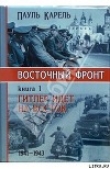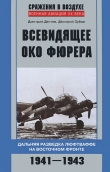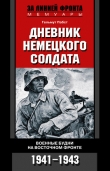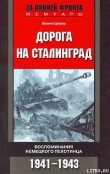
Текст книги "Rommel's Deutsches Afrika Korps 1941-1943"
Автор книги: Автор Неизвестен
Жанры:
История
,сообщить о нарушении
Текущая страница: 19 (всего у книги 19 страниц)
The organization and equipment of the Panzer-aufklarungsabteilung also did not prove successful. Rather, it left the regiments and battalions lacking their own efficient reconnaissance elements. As for the Panzerjagerabteilung was concerned, it was increasingly proposed to integrate it by companies into the infantry regiments or even into the Panzer-grenadierbataillone, since the antitank battalion was only suitable for limited separate employment anyway.
The Panzerkampfgruppe as an organization was not officially introduced during the war. Instead existing organizations were improved incrementally, such as by the formation of supply companies. Inadequate to the end were the numbers and the outfitting of the Panzergrenadiere, the latter due to the lack of adequate production of SPW's. Most were only motorized and, in fact, really only infantry, since they had to perform all assignments dismounted.
Panzerbrigade 1944
The activation of separate Panzerbrigaden was a half-hearted attempt to form streamlined armored maneuver formations {thirteen were planned altogether) . Certainly the intent in forming them was to create organic Panzer-kampfgruppen. The main deficiency, however, was in the totally inadequate logistics elements. The result was that these formations were "out of gas" within a few days. They were insufficiently capable of sustaining themselves as a separate formation.
Reorganization after Second World War
The new Bundeswehr was, it is true, primarily created by former Wehrmacht officers. However, wartime experiences were not always adopted in a consistent fashion. Of course, many aspects appeared again in the training. After a good beginning in 1956, however, much too large and ponderous divisions on the US pattern began to be formed. Introduced again was a situation where the lowest command level that was capable of combat with combined arms was at the level of the brigade, with similarly unwieldy Panzer or Panzergrenadier-bataillone.
During the 1970's there were several reorganizations, such as the formation of a fourth Panzer-/Panzergrenadierbataillon in the brigade. Nevertheless, the brigade was increasingly deprived of its logistical independence so that it was increasingly dependant upon the division or even the corps for command and control of combined arms operations.
The main reason for that, of course, was primarily the fact that the primary mission at the operational level—given the strategic framework at the time—was the defense of the national borders that were very close at hand. The Panzergrenadiere suffered a lot as a result. The unfortunate separation of the rifle squad from its armored personnel carriers and its commitment to digging into field fortifications was obligatory. Only the tanks were committed in mobile operations, but even they were often cooped up in the context of small battle positions in a stationary role. They assumed the role of mobile bunkers. The primary objective was not the defeat of the enemy but to hold onto terrain.
Entire generations of officers matured in that erroneous thought pattern. After the decline of the direct East-West confrontation, it required significant efforts to bring the setting of operational
objectives back to Panzer-type basics. There again, as in the 1920's and 1930's, the followers of the "pure theory" were confronted with the narrow-mindedness and provinciality of ignoramuses in operational theory.
Nevertheless, in Germany today, as earlier, the tactical/operational fundamentals for the commitment of Panzertruppen are used in a manner similar to the way they crystallized during the Second World War, even if obviously influenced by the present-day technological setting, the essentially greater significance of combat-support requirements and the increased effectiveness of all weapons against armor.
After this short historical overview let us have a close look at the German principles of armor warfare. I would like to start with the main types of combat (Gefechtsarten): offensive operations, defensive operations and delaying actions.
Maps







 Deutsches Afrika Korps 1941-43
Deutsches Afrika Korps 1941-43
Rommel (Panzer Army Africa) 14 February 1941 arrives in North Africa with Deutsches Afrika Korps, abbreviated DAK, to oppose a British desert force (later British Eighth Army) under Field Marshal Wavell threatening Tripoli. Military operations extending over two years involve DAK and-ltalian units in heavy fighting, developing into a confrontation between Army Croups; Afrika – First Italian Army (formerly Panzer Army Africa) plus Fifth Panzer Army versus British 18th Army Group – First and Eighth Armies plus US (II) and a French Corps.
Despite a nominal military balance, the key to successful panzer action lies in supply facilities, but German-Italian sea and air transports running a Mediterranean gauntlet, rarely escape the punishing attention of naval and air attacks mounted from Malta or Alexandria – notwithstanding the aggressive presence of German 2nd Air Fleet based in Sicily. Hitler's shortsightedness over reinforcements for Rommel, coinciding with an OKW view that the theatre is a sideshow, invites disaster and his decision to cancel 'Hercules', a Luftwaffe plan for eliminating Malta by airborne invasion, will prove fatal. Rommel (1) (Panzer Army Africa) 31 March 1941.'Sunflower' slowly increasing in power is Rommel's first offensive with DAK, but instead of 'blocking' Wavell, Rommel outmanoeuvres Eighth Army to reach Sollum on the Egyptian border but is thrown back to El Agheila.
DAK 5 Lt Div vanguard/Ariete, two It inf divs; by 20 November 1941 DAK = 21st, 15th Pz, part 90th Lt Div, 178 Pz Kpfw lll-IVs X AirCorps, 50 Stukas plus fighters.
Rommel (2) (Pz-Army Africa) 21 January 1942. Rommel's second offensive 'Theseus', as a Gruppe with more Italian units, develops into 'Venezia' capturing Tobruk (map 9) before pushing on to Alam Halfa/EI Alamein. A shortage of supplies, offsetting Rommel's often brilliant tactics, cripples panzer operations.
Pz-Gr Africa DAK as hitherto. 'Ariete', 'Trieste', 'Littorio' (arriving) four other It. divs inc. Trento, 560 tanks (320 Pz Kpfws) (see map 9). II Air Corps-j 530 aircraft inc. 80 Stukas.
Rommel (3) Pz-Army Africa 23 October 1942. The 'Desert Fox', promoted Field Marshal after a triumph at Tobruk (map 9), is defeated at El Alamein – and turns about. Pz-Army Africa at Alamein; DAK plus 164th Lt Div, Para Bde (Ramcke), It. deployment as hitherto plus Folgore (Para) Div. 285 Pz Kpfws – reduced to twenty by 4 November 1942; 150 German aircraft.
A hazardous withdrawal, almost 2,000 miles via Tripoli into Tunisia, is followed by 'Springwind' an offensive involving both PzAOKS and DAK in counter-attacks against US forces at Kasserine. PzArmy Africa (Messe) meanwhile faces Montgomery at Mareth; Rommel is now GOC, Army Group Africa – promoted 23 February 1943.
Von Arnim (4) 'Springwind', Fifth Panzer Army 14 February 1943, involves 10th, 21st Panzer and a DAK battle group in attacks against US II Corps at Kasserine, but suffers from poor co-ordination. After early success against an inexperienced US defence, the attack is called off. A new plan follows.
Fifth Pz-Army At Kasserine (Gruppe Zeigler) 15th, 21st Pz; DAK Battle Group (Liebenstein), 164th Lt, Centauro.
Rommel, Messe (5) 'Capri', Pz-Army Africa 6 March 1943. At Medenine with Rommel's help Messe's Pz-Army Africa strikes at Eighth Army forming up to assault Axis positions at Mareth. Rommel expects to prevent a British First and Eighth Army link-up, but the attack fails and 'Supercharge II', a British armoured counter-strike turns the defence, forcing Pz-Army Africa into retreat.
At Medenine 15th, 21st, 10th Pz, 90th Lt – 141 Pz Kpfws. Messe Thereafter Pz-Army Africa renamed Italian First Army withdraws to Enfidaville fighting rearguard battles. All German and Italian forces in North Africa capitulate on 13 May 1943.
Army Gr Africa Rommel, after 9 March 1943 von Arnim; Fifth Pz-Army, and It. First Army: ten German divs (three pz), six It. divs.
Western Desert Force/Eighth Army (1) Wavell, elements one armd div, three inf divs; by 20 November 1941 (Eighth Army), 6 divs (one armd) plus ind bdes, 577 tanks.
Br Eighth Army (5) Ritchie six divs (four mot, two armd) plus ind bdes 800-1,000 tanks, see (map 9) 530 aircraft.
(3)Montgomery ten divs (three armd) 1,200 tanks 1,200-1,500 aircraft.
Br First Army (4) Anderson: II US Corps (Fredendall) part 1st US Armd Div, Fr inf, later Br 6th Armd.
Br Eighth Army (5) Montgomery three divs (one armd), 300 tanks.
Br 18th Army Gr Alexander; Br First and Eighth Armies, 24 divs inc five US (two armd), four Fr, fifteen Br (four armd).

Map Leyend
1.Night of 14/15 June, the South African 1 st Division are in danger of being cut off and withdraw back through Tobruk to the frontier with Egypt.
2.Night of 14/15 June, the 50th Division is forced to break out of its encircled positions through Italian XXI Corps' lines and drive southwards around Bir Hacheim to the Egyptian border.
3.15 June, German 90.leichte Division makes repeated attacks on the El Adem position held by 29th Indian Brigade.
4.Afternoon 15 June, 21 .Panzer Division attacks and takes Point BB50
5.16 June, 7th Motor Brigade attacks the advancing Ariete Division north of El Adem, but the move is inconclusive and the brigade withdraws.
6.Early morning 17 June, 29th Indian Brigade withdraws from El Adem.
7.Afternoon 17 June, 21 .Panzer Division clashes with 4th Armoured Brigade between El Adem and Belhamed. The next day 4th Armoured Brigade withdraws to the south.
8.Night of 17 June, the two armoured divisions of the Afrika Korps turn north and reach the coast west of Gambut. Tobruk is now surrounded and all Eighth Army units that are still able to move retire eastwards to the Egyptian border.
9.19 June, Rommel now surrounds the Tobruk perimeter with Italian X and XXI Corps, the Italian Ariete Division and the Afrika Korps.
10.Early morning 20 June, the Afrika Korps breaks through Tobruk's perimeter and begins to eliminate the South African defences.
11.Afternoon 21 June, the garrison within the Tobruk area is overrun and Maj. Gen. Klopper surrenders his forces to Rommel.


Cyrenaica and Western Egypt May – November 1941
1. Oberschütze Maschinengewehrbatallion 2°, Tobruk, Cyrenaica May 1941
2. Schütze Panzerjägerabteilung 33°, Halfaya Pass, Egypt 1941
3. Unteroffizier Pionierbtallion (mot) 900°, Fort Capuzzo, Cyrenaica, November 1941

Africa February – April 1941
1. Generalmajor 5° Leichte Division, Tripoli, Tripolitania, March 1941
2. Hauptmann Panzerregiment 8°, Agedabia, Cyrenaica, April 1941
3. Obergefreiter Kradschützenbatallion 15°, Tobruk, Cyrenaica, April 1941
Bibliography
Adamthwaite, Anthony P (1992). The Making of the Second World War. New York: Routledge. ISBN 0-415-90716-0.
Brody, J Kenneth (1999). The Avoidable War: Pierre Laval and the Politics of Reality, 1935–1936. New Brunswick, NJ: Transaction Publishers. p. 4. ISBN 0-7658-0622-3.
Bullock, A. (1962). Hitler: A Study in Tyranny. London: Penguin Books. ISBN 0-14-013564-2.
Busky, Donald F (2002). Communism in History and Theory: Asia, Africa, and the Americas. Westport, CT: Praeger Publishers. ISBN 0-275-97733-1.
Davies, Norman (2008). No Simple Victory: World War II in Europe, 1939–1945. New York: Penguin Group. ISBN 0-14-311409-3.
Glantz, David M. (2001). "The Soviet-German War 1941–45 Myths and Realities: A Survey Essay". Archived from the original on 17 June 2011.
Graham, Helen (2005). The Spanish Civil War: A Very Short Introduction. Oxford and New York: Oxford University Press. ISBN 0-19-280377-8.
Holland, J (2006). Together We Stand, Turning the Tide in the West:North Africa, 1942–43. London: Harper Collins.
Hsiung, James Chieh (1992). China's Bitter Victory: The War with Japan, 1937–1945. M.E. Sharpe. ISBN 1-56324-246-X.
Jowett, Philip S.; Andrew, Stephen (2002). The Japanese Army, 1931–45. Osprey Publishing. ISBN 1-84176-353-5.
Kantowicz, Edward R (1999). The rage of nations. Wm. B. Eerdmans Publishing. ISBN 0-8028-4455-3.
Kershaw, Ian (2001). Hitler, 1936–1945: Nemesis. W. W. Norton & Company. ISBN 0-393-32252-1.
Kitson, Alison (2001). Germany 1858–1990: Hope, Terror, and Revival. Oxford: Oxford University Press. ISBN 978-0-19-913417-5.
Mandelbaum, Michael (1988). The Fate of Nations: The Search for National Security in the Nineteenth and Twentieth Centuries. Cambridge University Press. p. 96. ISBN 0-521-35790-X.
Murray, Williamson; Millett, Allan Reed (2001). A War to Be Won: Fighting the Second World War. Harvard University Press. ISBN 0-674-00680-1.
Myers, Ramon; Peattie, Mark (1987). The Japanese Colonial Empire, 1895–1945. Princeton University Press. ISBN 0-691-10222-8.
Preston, Peter (1998). 'Pacific Asia in the global system: an introduction, Wiley-Blackwell. Oxford: Blackwell. p. 104. ISBN 0-631-20238-2.
Record, Jeffery (2005). Appeasement Reconsidered: Investigating the Mythology of the 1930s (PDF). DIANE Publishing. p. 50. ISBN 1-58487-216-0. Retrieved 15 November 2009.
Shaw, Anthony (2000). World War II Day by Day. MBI Publishing Company. ISBN 0-7603-0939-6.
Smith, Winston; Steadman, Ralph (2004). All Riot on the Western Front, Volume 3. Last Gasp. ISBN 0-86719-616-5.
Weinberg, Gerhard L. (1995). A World at Arms: A Global History of World War II. Cambridge University Press. ISBN 0-521-55879-4.
Weinberg, Gerhard L. (2005). A World at Arms: A Global History of World War II (Second ed.). Cambridge: Cambridge University Press. ISBN 0-521-85316-8.
Zalampas, Michael (1989). Adolf Hitler and the Third Reich in American magazines, 1923–1939. Bowling Green University Popular Press. ISBN 0-87972-462-5.
Index
Deutsches Afrika Korps 5
Chapter I 9
Background to War 9
The Desert 16
Uniforms 20
Terrain 21
Tactics 23
Erwin Rommel 28
The Italians 29
British Army 30
Rommel arrives to Africa 32
Tobruk – First Attack 41
Sollum June 1941 51
Crusader 1942 57
Strike at Gazala 82
Battle of Alam Halfa – First Alamein 98
Tunisia Campaign 1942 111
Allies atack to Tunis 126
German contrattack 131
The North-Western Front 138
The Tunisian Bridgehead 143
Army Group Afrika Tunisia 150
Mareth Line 156
The End in Afrika 160
Chronology 165
Tank Engagement at Sollum 167
Feldmarshall Erwin Rommel 170
Poland 1939Rommel acted as commander of the Führerbegleithauptquartier (Führer escort headquarters) 174
France 1940 174
Invasion of France and Belgium 174
Battle of Arras 175
Drive for English Channel 176
North Africa 1941–1943 177
Plot against Hitler 178
Rommel's death 180
Erwin Rommel as Tactician 182
Popular perception 184
Annexes 185
Panzer Tactics 185
Development of German Armor Tactics 188
The First Three Panzerdivisionen 190
First Experience in War 192
Armored Battle Groups or Kampfgruppen 192
Panzerbrigade 1944 193
Reorganization after Second World War 193
Maps 195
Deutsches Afrika Korps 1941-43 202
Bibliography 209
Index 211
Notes 212 Notes
[1] General Feldmarshall Erwin Rommel
[2] Sir Archibald Wavell
[3] Panzerkampfwagen III
[4] Panzerkampfwagen II Ausf C 5° Leichte Division/5° Panzerregiment/I Battalion/2° Company
[5] Panzerkampfwagen IV Ausf D 5° Leichte Division/5° Panzerregiment/II Battalion/8° Company
[6] OKH: Oberkommando des Heeres
[7] A 105mm howitzer in action against Tobruk.
[8] Panzerkampfwagen II Ausf F 15° Panzer Division/Panzerregiment 8°/I Battalion/2° Company
[9] Panzerkampfwagen III Ausf J 15° Division Panzer/Panzerregiment 8°/I Battalion/2° Company
[10] General Sir Alan Cunningha Comander 8° Army
[11] A British machine gun Bren on an anti-aircraft mounting in Tobruk
[12] British tank Valentine of 23° Armoured Brigade knocked in Ruweisat Ridge.
[13] South African troops in infantry positions along the Gazala Line watch from their trench as a neraby position comes to attack.
[14] General Ludwig Crüewell
[15] Eight Army officers. From left to right: Lt General Norrie (XXX Corps), Lt. General Ritchie (Eight Army) and Lt. General Gott (XIII Corps).
[16] British Bren carriers of the 9° Rifle Brigade watch the destruction of a supply dump from a distance during retreat from the Gazala Line
[17] Eight Army withdrawal and Rommel attack on Tobruk
[18] Panzerkampfwagen VI Tiger 111 Panzer Abteinlung 501° in the desert North Africa
[19] German Intelligence Service
[20] Tiger used by the commander of the 1st Platoon of the 1st Company of s.Pz.Abt. 501°.
[21] Panzerkampfwagen VI Tiger I No 131 captured in Jebel Jaffa 21 April 1943
[22] Schwerer Panzerspähwagen (7.5cm) 10° Panzer Division/10° Motorcycle Battalion/5° Heavy Company
[23] 7.5cm Sturmgeschütz 40 Ausf F/8 10° Panzer Division/I Battalion/Sturmgeschütz Abteilung 242°
[24] Panzerkampfwagen VI Tiger I s.Pz.Abt 504°, tank number 142
[25] Albert, Kesselring, Wilhelm Speidel, Hermann Göring
[26] Panzerkampfwagen III Ausf J 3rd Platoon, 1st Company, s.Pz.Abt 504°
[27] 15cm sFH 13/1 (Sf) auf Geschützwagen Lorraine Schepper 21° Panzer Division/115° Artillery Regiment/3rd Battalion
[28] Leichter Gepanzerter Beobachtungskraftwagen 21° Panzer Division/115° Artillery Regiment
[29] Feldmarshal Erwin Rommel in Africa
[30] A memorial at the site of Field Marshal Erwin Rommel's suicide outside of the town of Herrlingen, Baden-Württemberg, Germany (west of Ulm).
[31] Erwin Rommel December 1943
[32] Panzerkampfwagen IV
[33] General der Panzertruppe Heinz Guderian








